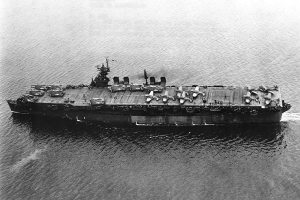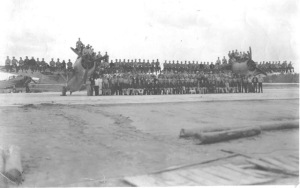The greatest thrill of his life came as he landed for the first time on the deck of an aircraft carrier at sea. Two years before in 1941, Elton Dale Snodgrass was a kid who read everything in the library and lived to go bowling and dancing. In the summer of 1941 he had just graduated high school in Terre Haute, Indiana. The summer after graduation is always memorable, the last vacation before friends got jobs or went off to college. The summer of 1941 was not special for that reason alone. It was the last summer before the storms in the East and West reached the isolationist beaches of the United States; the last summer where an eighteen year old from the Midwest would only have to worry about being a teenager. In December of that year, the Japanese bombed Pearl Harbor and changed the face of America.
Elton Snodgrass joined the Navy and went to Boot Camp in Great Lakes Illinois. He applied for pilot training but they made him an aerial gunner instead. Leaving Indiana, he carried two things from home, a pair of black converse sneakers he bought in high school for $9, and his nickname: “Jitterbug”, after the dance step he loved.
By November 1943, he was an Aviation Ordnance Man 2nd class, and a turret gunner on a Grumman TBF-1 Avenger torpedo plane in Torpedo Squadron Twenty-Two (VT-22) on sea duty aboard the USS Independence. He had already seen action in the Marcus Islands, and flown raids on Wake and Rabaul before VT-22 was given a new task. The Independence, along with the carriers USS Essex and Bunker Hill, was now part of Task Force 50.3, providing air support for the US Marine landings at the island of Betio in the Tarawa Atoll.
On November 18th the flight crews of the Independence, along with other carrier and land base planes launched 910 sorties against Betio, bombing the airfield and other installations, flying 170 sorties the day after.
At dawn on November 20th, Task Force 50.3 again launches its planes at the island, the focus is ground targets in preparation for the invasion. The planes land, and the naval bombardment of the island begins, and the first of the Marine assault force climbs into their landing craft. At nine in the morning, a half hour later than planned, the Marines make their way toward the island of Betio in the Tarawa Atoll.
VT-22 too heads toward Betio, flying continuing close air support missions. Below, landing craft shepherd the 18,600 Marines invading the island. The 1,900 horse power radial engine vibrates the airframe. The plane dips and climbs slightly as it navigates the tropical air.In the front of the Avenger, the pilot sees what is coming and reacts to it. The airplane responds to his touch, his desire. Below him, the radio operator has the most room, space to man the radios and the ventral machinegun, things to keep him occupied. The turret gunner’s world is confined to a metal seat with a 50. caliber machine gun, a thin veil of Plexiglas separating him from the blue sky. He is almost like a passenger, having no control over where he is going, just knowing whatever lies ahead will be dangerous and that he cannot see the danger because he faces the rear.
Jitterbug watches the sky and waits. He thinks of stuff from when he was a kid back in Indiana, things he carries with him in his mind. Stuff like selling strawberries in grade school, and waking up before the sun rose to work a milk route with his mother. His sister Doris, bowling with friends, the things that keep him going, things from the past he wants a future with. He thinks of Mary, the girl who waits for him. He retraces the steps of their last dance on the metal turret, the rubber soles of the black converse shoes muted by the engine noise. He carries his nickname with him too, written on his flight helmet and goggles.
There is another thing he carries, something he shares with every man on the plane and the men down below: fear. Fear as the ground at Betio flickers when the Japanese defenses open up, fear when black puffs of anti-aircraft buffet the plane, as tracer bullets fill the air with bright glowing streaks; fear that would change Jitterbug’s full head of black hair almost bald.
When they drop their bombs, they head back to the carrier. Below them the Marines are engaging the Japanese. There is smoke over the task force, and it is from the Independence. A torpedo from a Japanese plane struck its starboard side. The ship is badly damaged, its flight deck closed. Jitterbug’s Avenger makes an emergency landing on the USS Essex. The Independence sails to Funafuti, in the Ellice Islands for temporary repairs.
Two days later, the fight for Tarawa would be over. In three days, 1000 Marines and almost the entire Japanese garrison will lay dead on the island. There will be a documentary film about the battle that for the first time would show the American public the uncensored carnage of war.
Without a ship, Jitterbug’s crew flies raids with the Essex against Kwajalein before going to Pearl Harbor to catch up with the Independence as it heads to San Francisco.
In February 1944, Jitterbug would marry his sweetheart Mary while on a 30 day leave in the US. His crew would train for night flying before orders came for them to be shipped to the Pacific aboard the aircraft carrier USS Cowpens. On a stop at Pearl Harbor, Jitterbug’s application for pilot training is approved with orders back to San Francisco. His Avenger crew head to battle in the Pacific without him, where, on their first mission they are shot down and killed.
Jitterbug would never become a pilot with the US Navy. He was honorably discharged after a week of pilot training. He returned to Terre Haute, Indiana, the place he had left in 1942. He read in the library, bowled with his friends and danced with his wife. But things were never the same as they had been that summer long ago in 1941, when high school had finished and life was waiting to be found. Jitterbug had gone off to war and come back and life had moved on.







Wonderful Article that my 91 yr old Wonderful Dad “Jitterbug” and I so enjoyed 🙂
Amazing story! Thank you for printing it 🙂
Hello Terry,
I’m glad you liked it!
God bless Jitterbug for his service to our country. I can only pray that the red, white, and blue continues to run in the veins of our young people today, as it did, and always will, in the veins of Jitterbug–what a true patriot and what a true blue American!! Pam
Thank you for the comment Pam. I also hope that Americans will always follow the example of men like Jitterbug.
Thanks for sharing this story. You couldnt of written about a more deserving person “Jitterbug”.. truly enjoyed it !
I am very glad that you enjoyed it. I’m happy that I could help give Jitterbug some of the credit he deserves.
Masterful writing!
Thank you very much!
An amazing story about a wonderful man, that I’ve been fortunate enough to know for many years. Thanks for the story.
A wonderful story. Things were never the same again for those who lived through the events of the time….
I’m glad you enjoyed the story! Thanks for reading and commenting .
Thank you to “Dad” for your wonderful, brave service to ensure we can enjoy the freedoms we do today. The “greatest generation”…there will never be another!